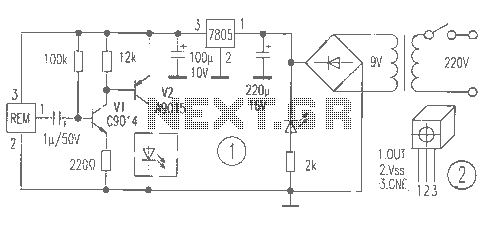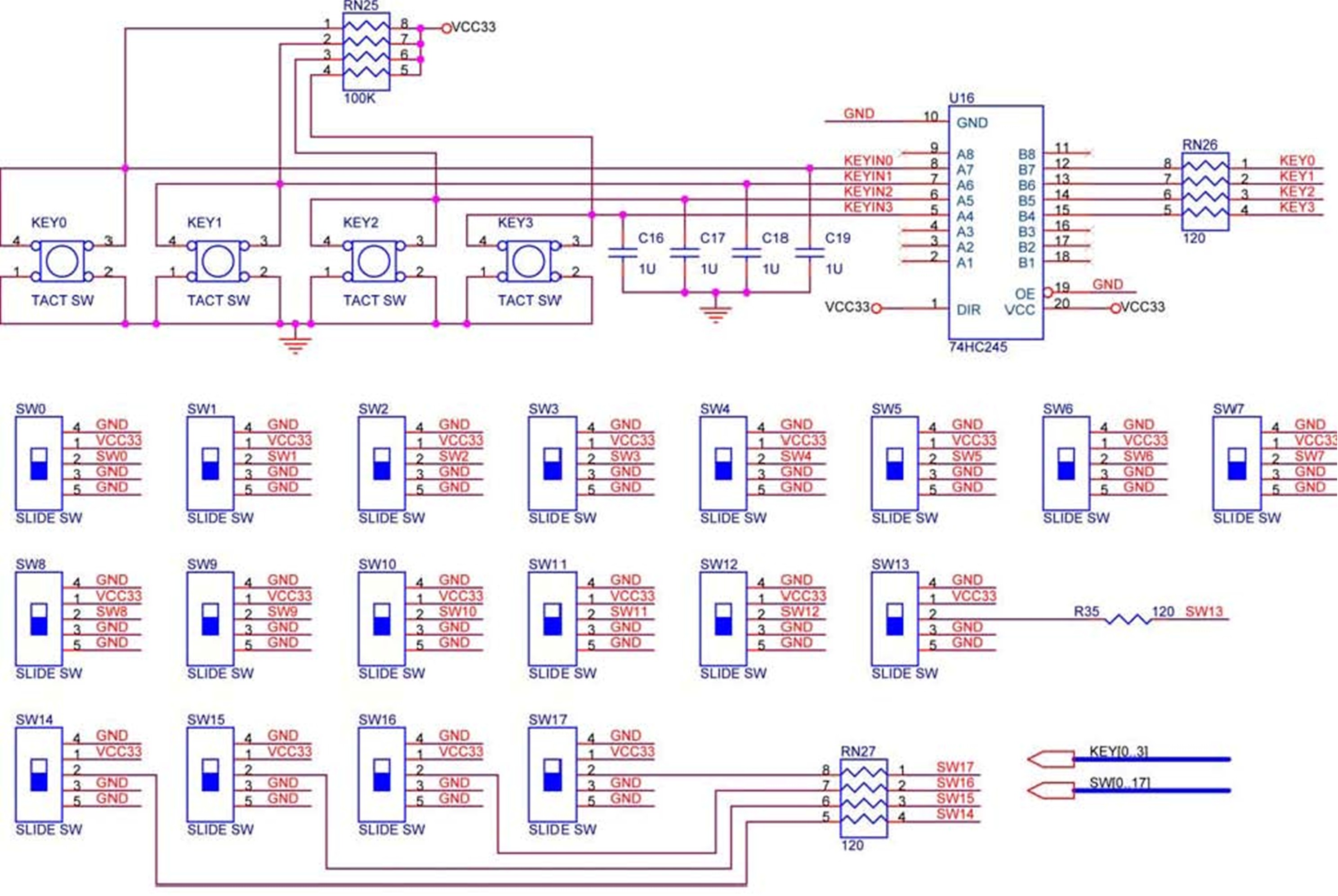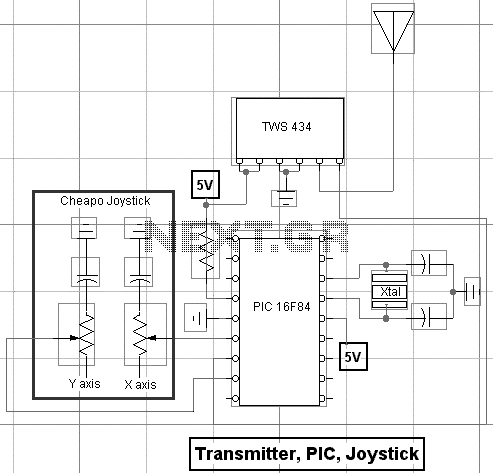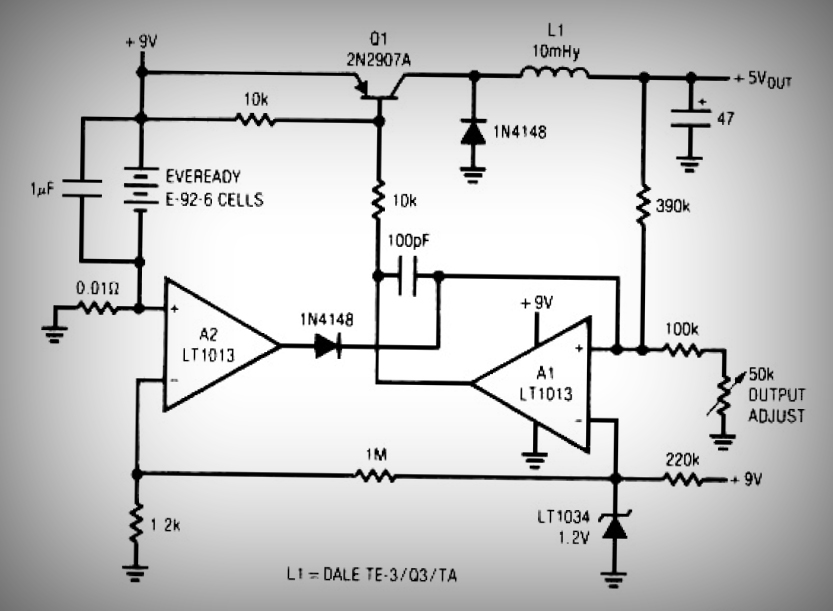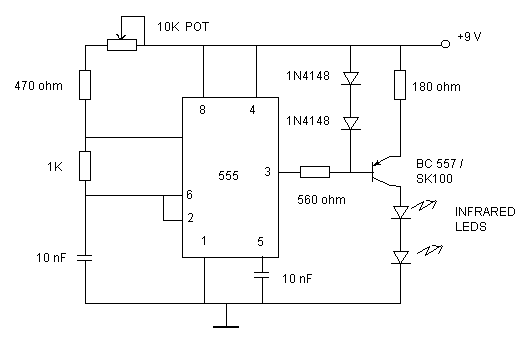
Remote Selection Video Switch
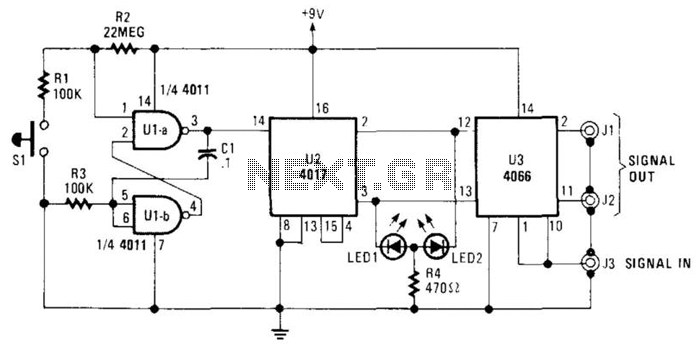
The A/B switch circuit comprises three integrated circuits (ICs) and several resistors. Two gates from a 4011 quad 2-input NAND gate (U1A and U1B) are configured as a monostable multivibrator. When switch SI is activated, it triggers a 4017 decade counter/divider, which is programmed to recycle after a count of two. The outputs from U2 at pins 2 and 3 are connected to the control inputs of U3 (a 4066 quad bilateral switch) at pins 12 and 13. Depending on which control input is activated, either the J1 or J2 output is selected. With minor modifications, the switch can be set to trigger at a predetermined rate automatically. By adding another 4066, the circuit can support up to eight channels. One potential application for this circuit is in a security surveillance system.
The A/B switch circuit is designed for flexible signal routing and can be effectively utilized in various electronic applications. The core of the circuit features the 4011 quad 2-input NAND gate, where two gates are configured to function as a monostable multivibrator. This configuration allows for a single pulse output when the switch SI is pressed, effectively creating a trigger signal. The monostable multivibrator output is fed into a 4017 decade counter, which counts pulses and is configured to recycle after reaching a count of two. This means that each time switch SI is pressed, the output of the 4017 changes state, allowing for toggling between two outputs.
The outputs from the 4017 IC, specifically pins 2 and 3, are utilized to control the 4066 quad bilateral switch (U3). The 4066 is capable of passing analog signals and can switch between different signal paths based on the control inputs from the 4017. When a control input is activated, it selects either output J1 or J2, enabling or disabling the corresponding signal path. This functionality is essential for applications where signal routing is required based on specific conditions or inputs.
For enhanced versatility, the circuit can be modified to allow for automatic triggering at a set rate. This could be achieved by integrating a timer circuit or additional components that generate periodic pulses, thus automating the switching process. Furthermore, by adding another 4066, the design can be expanded to accommodate multiple channels, potentially up to eight, which significantly increases its applicability in complex systems.
In practical applications, such as security surveillance systems, this A/B switch circuit can be employed to alternate between different video feeds or sensors, allowing for dynamic monitoring of various locations. The ability to control signal paths efficiently and automatically makes this circuit valuable in scenarios requiring real-time decision-making and signal management. The A/B Switch circuit consists of three ICs and a handful of resistors. Two gates from a 4011 quad 2-input N AND gate (U1A and U1B) are configured as a monostable multivibrator that, when switch SI is pressed, triggers a 4017 decade counter/divider, which has been set to recycle after a count of two. The outputs of U2 at pins 2 and 3 are fed to the control inputs of U3 (a 4066 quad bilateral switch) at pins 12 and 13.
Depending on which control input is high, either the J1 or J2 output is selected. With a little modification, the switch could be set to trigger at a set rate (automatically). With the addition of another 4066, it could have as many as 8 channels. One possible application would be in a security surveillance system.
The A/B switch circuit is designed for flexible signal routing and can be effectively utilized in various electronic applications. The core of the circuit features the 4011 quad 2-input NAND gate, where two gates are configured to function as a monostable multivibrator. This configuration allows for a single pulse output when the switch SI is pressed, effectively creating a trigger signal. The monostable multivibrator output is fed into a 4017 decade counter, which counts pulses and is configured to recycle after reaching a count of two. This means that each time switch SI is pressed, the output of the 4017 changes state, allowing for toggling between two outputs.
The outputs from the 4017 IC, specifically pins 2 and 3, are utilized to control the 4066 quad bilateral switch (U3). The 4066 is capable of passing analog signals and can switch between different signal paths based on the control inputs from the 4017. When a control input is activated, it selects either output J1 or J2, enabling or disabling the corresponding signal path. This functionality is essential for applications where signal routing is required based on specific conditions or inputs.
For enhanced versatility, the circuit can be modified to allow for automatic triggering at a set rate. This could be achieved by integrating a timer circuit or additional components that generate periodic pulses, thus automating the switching process. Furthermore, by adding another 4066, the design can be expanded to accommodate multiple channels, potentially up to eight, which significantly increases its applicability in complex systems.
In practical applications, such as security surveillance systems, this A/B switch circuit can be employed to alternate between different video feeds or sensors, allowing for dynamic monitoring of various locations. The ability to control signal paths efficiently and automatically makes this circuit valuable in scenarios requiring real-time decision-making and signal management. The A/B Switch circuit consists of three ICs and a handful of resistors. Two gates from a 4011 quad 2-input N AND gate (U1A and U1B) are configured as a monostable multivibrator that, when switch SI is pressed, triggers a 4017 decade counter/divider, which has been set to recycle after a count of two. The outputs of U2 at pins 2 and 3 are fed to the control inputs of U3 (a 4066 quad bilateral switch) at pins 12 and 13.
Depending on which control input is high, either the J1 or J2 output is selected. With a little modification, the switch could be set to trigger at a set rate (automatically). With the addition of another 4066, it could have as many as 8 channels. One possible application would be in a security surveillance system.
